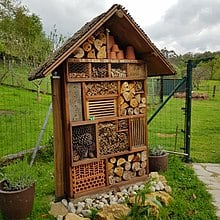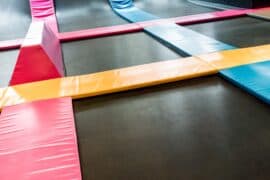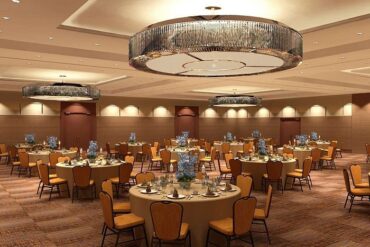Buzzy Buddies: The Ultimate Guide to Creating Insect Hotels for Parents
Hey there, eco-savvy parents! ? Are you looking for a delightful project that combines family bonding, education, and helping the environment? Well, roll up your sleeves, because today we’re diving into the whimsical world of insect hotels!
Insect hotels are not just charming additions to your garden; they’re vital havens for beneficial insects. By building a bug abode, you’re contributing to biodiversity and giving your kiddos a hands-on ecology lesson. ??
What is an Insect Hotel?
An insect hotel is a man-made structure designed to provide shelter for insects. Think of it as a five-star resort for your garden’s tiniest inhabitants! These structures can be made from natural, upcycled, or recycled materials and can cater to a variety of species, including solitary bees, ladybugs, and lacewings.
Why Build an Insect Hotel?
The benefits of insect hotels extend far beyond the “cute factor”. Here are some top reasons why creating one with your little bug lovers can be positively impactful:
- Pollinator Paradise: Many plants depend on insects like bees and butterflies for pollination. These tiny travelers contribute to the health of our ecosystems and the food we eat.
- Natural Pest Control: Insect hotels attract beneficial predators that help manage pest populations in your garden, reducing the need for chemical pesticides.
- Educational Experience: Building an insect hotel is an excellent way for your children to learn about the importance of conservation and biodiversity.
- Wildlife Conservation: With urban sprawl and habitat loss, providing a refuge for these creatures supports local wildlife sustainability.
Getting Started: What You’ll Need
Before we grab our tools, let’s gather the materials we’ll need. Feel free to be creative and use what you have on hand:
- Untreated wood or logs
- Bamboo canes or hollow stems
- Bricks with holes or old terracotta pots
- Straw, leaves, or pinecones
- Drill (for making holes in wood)
- Saw
- Hammer and nails or screws
- Non-toxic glue
- Wire or string (for hanging)
Remember, the goal is to use eco-friendly materials that won’t harm the insects or the environment. This is also a great chance to discuss recycling and reusing with your kids!
Designing Your Insect Hotel
When it comes to designing your insect hotel, the sky’s the limit! Here’s a basic structure to start with:
- Create a sturdy frame using the untreated wood or logs. This can be a cube, a rectangle, or any shape you fancy.
- Fill the frame with layers of bamboo canes, hollow stems, bricks, and other materials. These layers create a mosaic of tiny rooms for different insects.
- Ensure there are plenty of different sized holes and cavities for various insect sizes. Drill holes into logs or blocks of wood for solitary bees, leaving the back closed so they can lay their eggs safely.
- Stack your materials with care, ensuring they’re snug but have enough space for insects to crawl in.

The Definitive Parent’s Guide to Insect Hotels: Crafting a Bug Paradise
5 Things Parents Should Know in Preparing for Insect Hotels
Before jumping into the construction, there are a few things you, as a parent, should consider to make this experience as enriching as possible:
- Safety First: While it’s a fun family activity, working with tools and materials means you need to prioritize safety. Always supervise your children, use protective gear, and choose age-appropriate tasks for your little ones.
- Location, Location, Location: Insect hotels should be placed in a quiet, sheltered part of the garden, where beneficial insects are most likely to visit. Consider factors like sunlight, wind, and proximity to plants when choosing the perfect spot.
- Choosing the Right Materials: Insects have preferences too! Use diverse materials like bamboo, wood, and pine cones to attract a variety of species. Also, opt for untreated wood to avoid chemicals that could harm the bugs.
- Engage in Learning: Turn every step into an educational opportunity. Discuss the types of insects you’re likely to attract and their roles in our ecosystem. Spark curiosity about the natural world within your children.
- Patience is Key: It might take a while for insects to take up residence in your new hotel. Use this time to observe changes, discuss with your children what might be happening inside, and keep an eye out for the first guests.
Creating an insect hotel can be a blast and it’s wonderful to see your garden buzzing with new life. Just remember, each insect hotel is as unique as the family who builds it. Embrace the quirks, laugh off the hiccups, and enjoy the process of building and learning together!
Now that you’re equipped with the know-how and prepared with the key considerations, it’s time to invite the world of bugs into your garden. Stay excited, have fun, and let the magic of the natural world unfold right before your eyes!
See more great Things to Do with Kids in New Zealand here. For more information see here
Disclaimer
The articles available via our website provide general information only and we strongly urge readers to exercise caution and conduct their own thorough research and fact-checking. The information presented should not be taken as absolute truth, and, to the maximum extent permitted by law, we will not be held liable for any inaccuracies or errors in the content. It is essential for individuals to independently verify and validate the information before making any decisions or taking any actions based on the articles.




